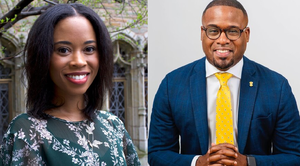When you think of Black religious history in America, one image likely comes to mind: the Black Church.
Scholars regard the Black Church as the oldest Black institution in the United States, one that has given Black people a space to worship on their own terms and work through shared questions about their future in this country.
While Leonard Cornell McKinnis II and Alexia Williams, professors of religion and African American studies, join religious scholars across the country in recognizing the strength of the Black Church in history—and its role in helping Black people gain an identity—they’re also working to widen the narrative.
“Traditionally, when Americans describe the Black Church, they think of a Black, Protestant, male-led movement that is unified and has a shared sense of identity and sociopolitical destiny,” said Williams. “But really, there are so many diverse religious experiences among Black peoples in America. Focusing on the Black Church as a symbol of all Black religions makes it difficult to recognize traditions that didn’t emerge from antebellum slavery.
Both Williams and McKinnis are working to change that through their research and teaching. In their classrooms, they emphasize the more recent migrations of Black people from the Caribbean and West Africa during the 20th century, for instance, and the subsequent proliferation of new religious movements and experiences that depart from Black Christianity and Black Protestantism in specific ways. They also emphasize the importance of acknowledging the differences that come with time.
“So many people continue to think about the Black Church through the lens of the Civil Rights Movement of the 1950s-1960s, but Black religious cultures are not stagnant. The Black Church of the Civil Rights Era is not the Black Church of today,” said Williams. “If this monolithic version of the Black Church is taken for granted as representative of all Black religions in the U.S., then it becomes difficult to recognize the contributions of women, LGBTQ+ communities, Afro-diasporic religious communities and other black identity groups aside from our iconic Black male Christian ministers.”
“In other words, what we’re pushing here is that the term Black religion or the Black Church does not capture the complexity of the religious lives of African Americans,” said McKinnis. “The religious lives of African Americans are wide, diverse, different histories, different starting points, different theologies.”
He writes about this idea in an extended footnote of his new book, “The Black Coptic Church: Race and Imagination in a New Religion.” The question, “What does it mean to imagine Blackness?” is at the center of the book, which is the result of a 10-year ethnographic study of the Black Coptic tradition. It provides a more complex look at the diverse world of Black religious life in North America, particularly within non-mainstream Christian churches.
Williams is working on a book about African American candidates for sainthood, titled “Black Revolutionary Saints: Roman Catholicism and the U.S. Racial Imagination.” It examines veneration of African Americans on the path to sainthood to understand how Roman Catholicism operates as a site of Black political organizing and cultural production.
Their ongoing—and necessarily disruptive work—is part of what makes them such impactful additions to the Department of Religion and campus as a whole.
“Part of what we are up to as scholars is that we are both trying to complicate the story,” said McKinnis. “We are both trying to tell articulate a fuller more comprehensive story of race, religion, and identity in America. Students at the U of I won’t get that same one-dimensional story of the Black Church from us.”
It’s that work and that mentality that Jon Ebel, head of the Department of Religion, finds most inspiring.
“The two together have been proposing new classes, teaching new classes, teaching old classes in new ways, traveling all over the country to deliver talks and to show colleagues from coast to coast and everywhere in between how vibrant the study of religion is at Illinois,” said Ebel. “They inspire me and the rest of our faculty every day with their brilliance as teachers and their deep expertise in African American religions and in the entire scope of American religion and culture.”
McKinnis said that’s the reason their work fits so nicely together: they’re both invested in a more diverse view of Black religions and the Black Church.
“It’s a story of migration,” he said. “It’s a story of Catholicism. It’s a story of Pentecostalism. It’s a story of Islam. It’s a story of nonbelievers. That’s really what we’re trying to convey here.”
Dania De La Hoya Rojas
Editor's note: This story first appeared in the School of Literatures, Cultures & Linguistics Fall 2023 newsletter.
